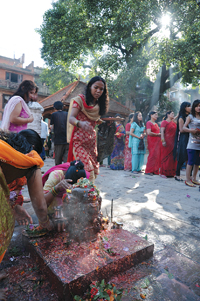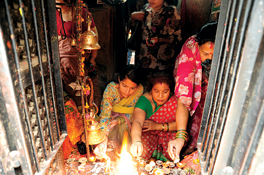M ondays celebrate Lord Shiva, Tuesdays, the elephant headed god Ganesha, Thursdays are for Devis or female deities, especially Bangalamukhi in Patan, while Saturdays are segregated for the planet god Shani or Saturn. These deities represent various aspects of life, venerated on certain days of the week. Their devotees queue up in temples offering objects believed to appease them. Devotees of Lord Ganesha, for example proffer rounded sweets or laddus, those of Lord Shiva offer milk and curd while followers of Shani use black sesame seed, black clothes and metal objects, respectively. Fasting, however, is the one common ritual among all these devotees.
 A mixed bag of dos and don’ts, Hindu culture and customs are often complicated and sometimes downright superstitious. Among them, fasting, nevertheless, spells some little logic. An act of utter devotion, this abstinence from food is practiced in the name of God – which is believed to earn them eternal blessing and prosperity and often times, wealth and fertility. Different kinds of ritualistic fasts are observed in various religious occasions, each of which bears individual meaning.
A mixed bag of dos and don’ts, Hindu culture and customs are often complicated and sometimes downright superstitious. Among them, fasting, nevertheless, spells some little logic. An act of utter devotion, this abstinence from food is practiced in the name of God – which is believed to earn them eternal blessing and prosperity and often times, wealth and fertility. Different kinds of ritualistic fasts are observed in various religious occasions, each of which bears individual meaning.
Teej is typically a women’s festival. Married and unmarried young women throng to the Pashupatinath Temple in Kathmandu. Dressed completely in red, they practice serious fasting even without drinking water. It symbolizes the devotion to their husband and a vow for his longevity. This festival mostly falls in the month of September.
Rishi Panchami is a similar, women’s festival where young unmarried women fast in anticipation of getting good husbands. The festival follows closely after Teej.
Swasthani Brata - Based on the pantheon of Swasthani Devi, a devotee of Lord Shiva, married and unmarried Hindu women fast for a period of one month - eating only one time a day, and follow a strict vegetarian diet. It starts on the full moon day of Poush (January) and ends a month later, on the full moon day of Magh (February).
Fasting on ekadashi or, the eleventh day of each lunar month, is also a common practice. Even the ones who do not fast, adhere to a vegetarian diet. Fasting in ekadashi relates to more than just abstinence of food and restrictions of all five sensory pleasures. For the yearly 24 ekadashis, the month of Mangsir - eighth month of the Nepalese calendar (Aug-sept) is taken as the starting point.
 Haribodhani Ekadashi is probably the most important of all ekadashis, which falls on the eleventh day of Kartik – seventh month of the Nepalese calendar (July-Aug). Devotees fast and donate money, foods and clothes on this day.
Haribodhani Ekadashi is probably the most important of all ekadashis, which falls on the eleventh day of Kartik – seventh month of the Nepalese calendar (July-Aug). Devotees fast and donate money, foods and clothes on this day.
A family mourning period is another such occasion that calls for intense, mandatory fasting. The closest family members, especially sons, perform Shradhaa, a yearly ceremonial commemoration of the deceased members of a family. Starting from the day prior to the shradhaa, they observe a half-day fast, following a strict salt free, vegetarian diet, until the ceremony lasts. Food, clothes and money are donated on this day.
Immediate family members, upon the death of their parents or grandparents, observe a 13-day fast. The sons shave their head and dress in white cotton clothes segregating themselves from the rest of the family. Any kind of sensory pleasure, including bathing, is restricted during this period and all the meals must be plain and salt free. The same applies to widowed wives upon death of their husband.
Fasting, therefore, is as much a part of life, as there are different festivals and celebrations in Nepal. This practice can well be accounted for as a calculated, traditional detox method.

The Goddess among Men: Chronicles of a former Kumari
Transition back to regular life wasn't easy for Preeti Shakya, a former Kumari. In that role, she was loved and...









